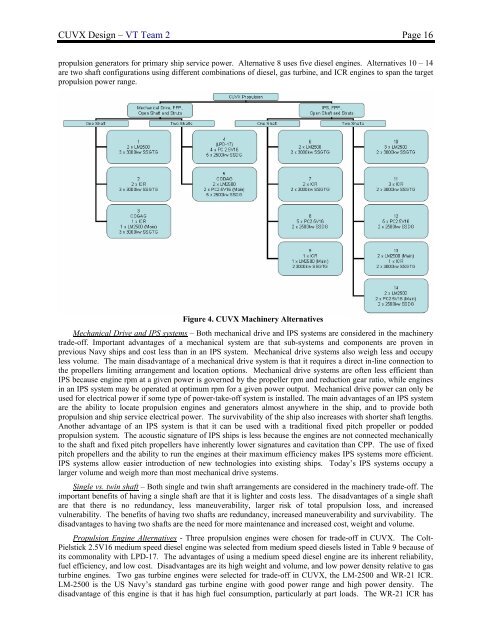CUVX Design Report - the AOE home page - Virginia Tech
CUVX Design Report - the AOE home page - Virginia Tech
CUVX Design Report - the AOE home page - Virginia Tech
You also want an ePaper? Increase the reach of your titles
YUMPU automatically turns print PDFs into web optimized ePapers that Google loves.
<strong>CUVX</strong> <strong>Design</strong> – VT Team 2 Page 16propulsion generators for primary ship service power. Alternative 8 uses five diesel engines. Alternatives 10 – 14are two shaft configurations using different combinations of diesel, gas turbine, and ICR engines to span <strong>the</strong> targetpropulsion power range.Figure 4. <strong>CUVX</strong> Machinery AlternativesMechanical Drive and IPS systems – Both mechanical drive and IPS systems are considered in <strong>the</strong> machinerytrade-off. Important advantages of a mechanical system are that sub-systems and components are proven inprevious Navy ships and cost less than in an IPS system. Mechanical drive systems also weigh less and occupyless volume. The main disadvantage of a mechanical drive system is that it requires a direct in-line connection to<strong>the</strong> propellers limiting arrangement and location options. Mechanical drive systems are often less efficient thanIPS because engine rpm at a given power is governed by <strong>the</strong> propeller rpm and reduction gear ratio, while enginesin an IPS system may be operated at optimum rpm for a given power output. Mechanical drive power can only beused for electrical power if some type of power-take-off system is installed. The main advantages of an IPS systemare <strong>the</strong> ability to locate propulsion engines and generators almost anywhere in <strong>the</strong> ship, and to provide bothpropulsion and ship service electrical power. The survivability of <strong>the</strong> ship also increases with shorter shaft lengths.Ano<strong>the</strong>r advantage of an IPS system is that it can be used with a traditional fixed pitch propeller or poddedpropulsion system. The acoustic signature of IPS ships is less because <strong>the</strong> engines are not connected mechanicallyto <strong>the</strong> shaft and fixed pitch propellers have inherently lower signatures and cavitation than CPP. The use of fixedpitch propellers and <strong>the</strong> ability to run <strong>the</strong> engines at <strong>the</strong>ir maximum efficiency makes IPS systems more efficient.IPS systems allow easier introduction of new technologies into existing ships. Today’s IPS systems occupy alarger volume and weigh more than most mechanical drive systems.Single vs. twin shaft – Both single and twin shaft arrangements are considered in <strong>the</strong> machinery trade-off. Theimportant benefits of having a single shaft are that it is lighter and costs less. The disadvantages of a single shaftare that <strong>the</strong>re is no redundancy, less maneuverability, larger risk of total propulsion loss, and increasedvulnerability. The benefits of having two shafts are redundancy, increased maneuverability and survivability. Thedisadvantages to having two shafts are <strong>the</strong> need for more maintenance and increased cost, weight and volume.Propulsion Engine Alternatives - Three propulsion engines were chosen for trade-off in <strong>CUVX</strong>. The Colt-Pielstick 2.5V16 medium speed diesel engine was selected from medium speed diesels listed in Table 9 because ofits commonality with LPD-17. The advantages of using a medium speed diesel engine are its inherent reliability,fuel efficiency, and low cost. Disadvantages are its high weight and volume, and low power density relative to gasturbine engines. Two gas turbine engines were selected for trade-off in <strong>CUVX</strong>, <strong>the</strong> LM-2500 and WR-21 ICR.LM-2500 is <strong>the</strong> US Navy’s standard gas turbine engine with good power range and high power density. Thedisadvantage of this engine is that it has high fuel consumption, particularly at part loads. The WR-21 ICR has
















